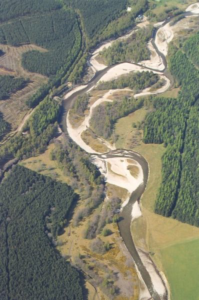Sounding out the river: a new system for monitoring bedload mobilisation and transportation
The challenge
Recording the onset and flux of sediment bedload in rivers is a missing component of our digitally enabled environment. The mobilisation and transport of coarse bedload has a profound impact on the evolution of mountain rivers and the alluvial plains they feed [1]; this then impacts communities that depend on these rivers for agriculture. For example, bedload played a key role in a major channel avulsion of the Kosi River (Nepal) in 2008 which resulted in the displacement of ~2.9M vulnerable people and the deposition of gravels across agricultural land caused the long-term devastation of arable land [2]. During extreme events, the erosive impact of flood waters poses a risk to infrastructure such as undercutting of bridges and embankments [3] and the dynamic nature of the bed creates uncertainty for river and flood management [4]. In the longer term, where climate change drives increased frequency and severity of flood events, the bedload mobilisation can propagate these effects through the landscape. Our ability to forecast the evolution of such systems is particularly difficult because (i) mobilisation occurs at a finite threshold flow rate which changes between events, (ii) the evolution of the system thereafter is non-linear, and (iii) the system response is different for rising or falling water level (hysteresis). There is no unifying model for these effects, largely due to the lack of data to test competing hypotheses. Here we will (a) use real-time monitoring to test the science of bedload mobility and (b) develop a new capacity to enable operational responses to evolving threats.
Blog Posts
- GEODUINO DEV: Power to the geoduino
- STUDENT STORY: Looking back over my first year as a PhD student
- GEODUINO TECH: Programming the geoduino
- GEODUINO SKILLS: Development Board Choice
- TECH DEVELOPMENT: BatMan (Battery Management)
Project Partner Prof Karen Mair has also generated a sonifcation inspired by the work in this project as part of her Fieldtrips Through Sound work called River Rumblings – Thaw.
Project Team
Calum Cuthill (PDRA): Low cost sensor development
Bronwyn Matthews (EPSRC PhD):
PI: Dr Mark Naylor (Edinburgh)
CoI: Prof Hugh Sinclair (Edinburgh)
CoI Dr Andrew Black (Dundee)
CoI: Dr Richard Williams
CoI: Dr Wouter Buyaert
Project Partner Micha Dietze
Project Partner: Prof Karen Main
Funding
PI (£220k) 2020-2222 Sounding out the river: a new system for monitoring bedload mobilisation and transportation (NERC Digital Environment call, with 20%FEC) This is a cross-disciplinary project I submitted with Glasgow, Dundee, Imperial College and SEPA to monitor bedload transport on the River Feshie.
CoI 2020 £36k PI Sinclair Edinburgh GCRF Fund: Monitoring and awareness of the role of river sediment in flood protection in Nepal
References
[1] Ryan, et al. (2002) Defining phases of bedload transport using piecewise regression, Earth Surface Processes and Landforms, 27.
[2] Sinha et al (2013), Exploring the channel connectivity structure of the August 2008 avulsion belt of the Kosi River, India: Application to flood risk assessment, Geology, 41(10).
[3] Lamb et al (2017) Vulnerability of bridges to scour: insights from an international expert elicitation workshop, Nat. Hazards Earth Syst. Sci., 17.
[4] , & (2015) Hydrologic versus geomorphic drivers of trends in flood hazard, Geophys. Res. Lett., 42.



Comments are closed
Comments to this thread have been closed by the post author or by an administrator.